
Brassica is a genus of plants in the mustard family (Brassicaceae). The members of the genus are informally known as cruciferous vegetables, cabbages, or mustard plants. Crops from this genus are sometimes called cole crops—derived from the Latin caulis, denoting the stem or stalk of a plant.
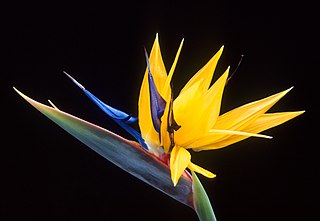
Strelitzia is a genus of five species of perennial plants, native to South Africa. It belongs to the plant family Strelitziaceae. The genus is named after the duchy of Mecklenburg-Strelitz, birthplace of Queen Charlotte of the United Kingdom. A common name of the genus is bird of paradise flower / plant, because of a resemblance of its flowers to birds-of-paradise. In South Africa it is commonly known as a crane flower and is featured on the reverse of the 50 cent coin. It is the floral emblem of the City of Los Angeles; two of the species, Strelitzia nicolai and Strelitzia reginae, are frequently grown as house plants.

Freesia is a genus of herbaceous perennial flowering plants in the family Iridaceae, first described as a genus in 1866 by Christian Friedrich Ecklon (1886) and named after the German botanist and medical practitioner, Friedrich Freese (1795-1876). It is native to the eastern side of southern Africa, from Kenya south to South Africa, most species being found in Cape Provinces. Species of the former genus Anomatheca are now included in Freesia. The plants commonly known as "freesias", with fragrant funnel-shaped flowers, are cultivated hybrids of a number of Freesia species. Some other species are also grown as ornamental plants.
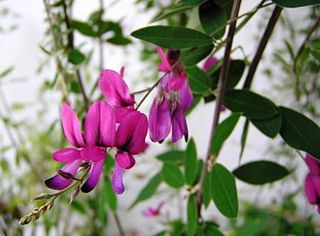
Lespedeza is a genus of some 40 species of flowering plants in the pea family (Fabaceae), commonly known as bush clovers or Japanese clovers (hagi). The genus is native to warm temperate to subtropical regions of eastern North America, eastern and southern Asia and Australasia.

Viminaria juncea is the single species in the genus Viminaria endemic to Australia. The genus is in the pea family Fabaceae. It is colloquially known as native broom after its resemblance to the related European broom plants. The Noongar peoples know the plant as koweda.

Brassica juncea, commonly brown mustard, Chinese mustard, Indian mustard, leaf mustard, Oriental mustard and vegetable mustard, is a species of mustard plant.

Arenaria is a genus of flowering plants, within the family Caryophyllaceae.
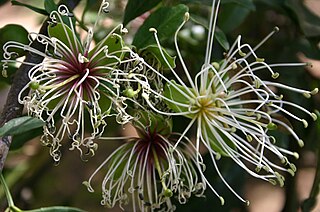
Maerua is a genus of plants in the family Capparaceae, with its centre of diversity in Africa, though some species extend their range as far north as the Levant, and as far east as the Indian subcontinent. Among its species:

Sowerbaea is a small genus of perennial herbs which are endemic to Australia.
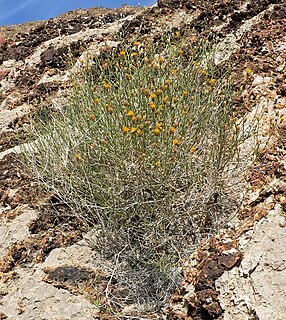
Bebbia, common name sweetbush, is a genus of aromatic shrubs in the daisy family.
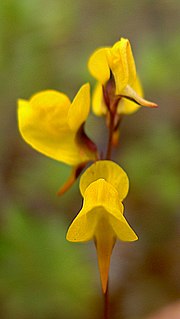
Utricularia juncea, the southern bladderwort, is a small to medium sized, probably perennial carnivorous plant that belongs to the genus Utricularia. U. juncea is native to Central, South, and North America. It grows as a terrestrial plant in marshes, swamps, and pools in shallow waters, mostly at lower altitudes. It was originally described and published by Martin Vahl in 1804.

Lygodesmia, called skeletonplant, is a genus of North American flowering plants in the dandelion tribe within the sunflower family.

Strelitzia juncea, the rush-leaved strelitzia or narrow-leaved bird of paradise, is a monocotyledonous flowering plant that is indigenous to South Africa. This drought resistant Strelitzia occurs sparingly near Uitenhage, Patensie and just north of Port Elizabeth. It is threatened in part by illegal removal for horticultural purposes. This species is thought to be one of the most frost resistant of the genus Strelitzia.
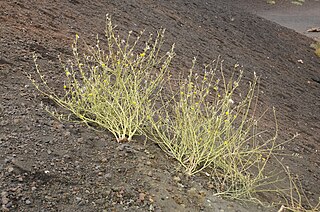
Chondrilla is a genus of flowering plants in the aster family, Asteraceae. They are native to Eurasia, and certain taxa are known as introduced species outside their native range. The best known of these is rush skeletonweed, a noxious weed established in Africa, Australia, and the Americas.
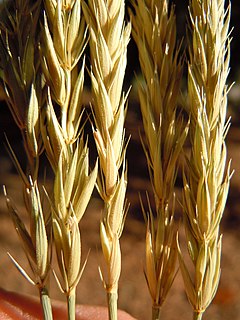
Psathyrostachys juncea is a species of grass known by the common name Russian wildrye. It was formerly classified as Elymus junceus. It is native to Russia and China, and has been introduced to other parts of the world, such as Canada and the United States. Psathyrostachys juncea is a great source of food for grazing animals, as it has high nutrition value in its dense basal leaves, even in the late summer and autumn seasons. This species can grow and prosper in many harsh environments, making it an ideal candidate for improvement as it can grow in areas were farming is difficult. This species is a drought-resistant forage plant and can survive during the cool seasons. It is also a cross-pollinator and is self-sterile. This means that P. juncea cannot self-fertilize; it must find another plant of the same species with which to exchange gametes. Self-sterilization increases the genetic diversity of a species.

Belonogaster is a large genus of mainly Afrotropical quasisocial wasps, although some species occur in Arabia and two extend as far as India. They have characteristics of both the eusocial and the solitary wasps. Belonogaster constructs communal paper nests where the grubs are fed on masticated, soft-bodied insects such as caterpillars. The type species is Belonogaster juncea, which consists of two subspecies: Belonogaster juncea colonialis and Belonogaster juncea juncea. Belanogaster wasps are an important food source for wintering European honey buzzards in sub-Saharan Africa. In African traditional medicine, wasps of the genus are cooked with plant roots and consumed to cure various childhood sicknesses, as well as having ceremonial use similar to that of honey bees. Some birds choose to build their nests near the nests of Belonogaster for protection, including mousebirds and weavers.

Belanogaster juncea is a typical quasisocial paper wasp from sub-saharan Africa and south-western Asia. It is the type species for the genus Belonogaster.
Belonogaster juncea juncea is a subspecies of Belonogaster juncea and is classified as a primitively eusocial wasp, meaning that the species is social while exhibiting a morphology that is indistinguishable from that of other castes. It is also classified as a type of African Paper Wasp. Many of the studies relating specifically to B. j. juncea take place at the University of Yaoundé in Cameroon.
Epectasis is a genus of longhorn beetles of the subfamily Lamiinae, containing the following species:
Stenomelania juncea is a species of freshwater snail, an aquatic gastropod mollusk in the family Thiaridae.

















